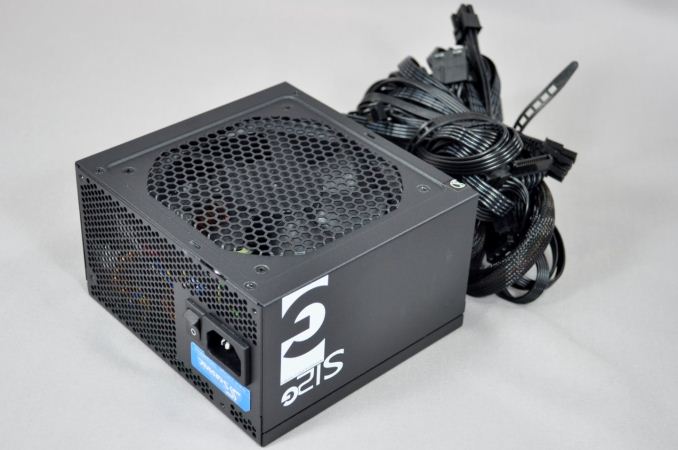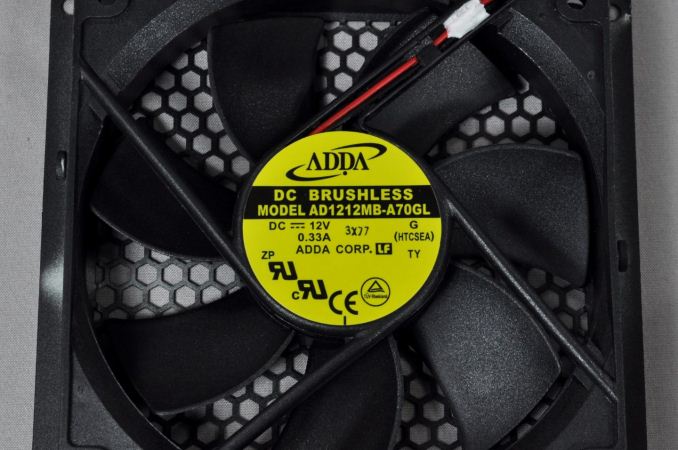Seasonic S12G 650W Power Supply Review
by E. Fylladitakis on February 28, 2014 2:20 PM EST- Posted in
- Cases/Cooling/PSUs
- Seasonic
- 80 Plus Gold
External Appearance
The Seasonic S12G sports a small, typical ATX-sized (140mm) chassis that has been sprayed with a matte black paint. Some effort has been made to improve the appearance of the power supply, albeit not all of the measures can be considered successful. Seasonic uses all-black ribbon cables, with the exception of the 24-pin ATX cable that uses typical color-coded wires and sleeving. A blue sticker has been placed on the rear of the unit, where it will be visible from the back of a case once the PSU has been installed. Oddly enough however, the company sprayed the series logo in white on the right side of the chassis, where it will be facing the right side panel of a case. It goes without saying that it will not be visible inside the vast majority of the cases currently in the market. On the other hand, the sticker with the specifications of the PSU has been placed on the left side of the chassis. No effort has been made at all to enhance the top side of the chassis visually, so in a bottom-mounted location users with case windows will simply see a black surface.
Internal Design
We were surprised the instant that we opened up the chassis of the S12G 650W unit. The unit is cooled by an ADDA AD1212MB-A70GL fan, unlike the majority of Seasonic's other models that use SanAce fans. The particular fan model is high quality, featuring a "Hypro" liquid bearing and with a maximum speed of 2050 RPM, yet it is no SanAce. When you have to compete in the mainstream market and even a few dollars can make an immense difference on sales, you have to keep the retail price as low as possible, which is most probably why Seasonic went with the ADDA fan for the S12G. Note also that as this unit has no fanless mode, it does not require a fan with extraordinary specifications (e.g. a very low starting voltage).
It is obvious that the OEM behind the S12G is Seasonic, as the company designs, manufactures, and markets their own units. We spot four heatsinks; the smallest one handles the rectifier bridge, the one near the edge of the PCB cools the active PFC components, and those on each side of the main transformer handle the inversion and conversion transistors of the primary and secondary stage respectively. The input filter begins on the PCB attached to the back of the receptacle, but continues on the main PCB until the input of the rectifier bridge. We spot a total of six Y capacitors, two X capacitors, and two filtering inductors, which form an excellent intake filter.
In terms of component and build quality, Seasonic does not let us down. The primary capacitor and most of the smaller capacitors are supplied by Nippon Chemi-Con, with some Rubycon electrolytic capacitors after the secondary side heatsink as well. Everything is well shielded and secured with glue, ensuring the mechanical cohesion of the unit. The inductors are glued and also tightened with cable ties, in order to minimize the chance of vibration-generated noise (also known as "coil whine"). The quality of the soldering is very good, well above what we would consider average. There are a few spots where excessive solder has been applied, but that hardly is worth commenting on in a $90 MSRP PSU.






















77 Comments
View All Comments
E.Fyll - Saturday, March 1, 2014 - link
That will happen too. Companies (and consumers) generally favor large PSUs at the moment and there are very few high performance, low wattage models. I certainly do not plan on testing high output units alone though, neither focusing on just a single "class" of products. Patience, I can only do one at the time. In time, there will be a good variety of reviews, of every output/range/class.pandemonium - Friday, February 28, 2014 - link
Nice read. I went for the big brother instead about a month ago when my Corsair TX650 decided enough was enough: http://www.newegg.com/Product/Product.aspx?Item=N8...Talcite - Saturday, March 1, 2014 - link
Glad to see PSU reviews have returned!CknSalad - Saturday, March 1, 2014 - link
There's a 360 watt version of this Seasonic brand line. Honestly anything 660/7870 and less just get a quality 360-400 watt psu so your efficiency is also decent under non-gaming/non-intensive loads. 550 watt for a high end single-gpu system (Titan/780 TI/290/290x). GPUs in between those mentioned above a quality 450w psu is good enough.FriendlyUser - Saturday, March 1, 2014 - link
I applaud the newer testing methodology for cases and PSUs. Great job.I am a fan of Seasonic PSUs and have been buying them for a few years. Since I started using Seasonic PSUs I have observed a very low component failure rate for my HD, GPUs etc. Maybe because of very low ripple or because of excellent voltage regulation? Anyway, worth investing in a high-end PSU.
E.Fyll - Saturday, March 1, 2014 - link
Indeed. Most people do not realize that but power quality (ripple/noise suppression mostly) is, in my opinion, by far the most important aspect of a PSU. It hardly affects the performance of the PSU itself but it has a dramatic impact on the longevity and reliability of your system's components.Do not be fooled however, low ripple does not mean low noise; you can easily have a low ripple signal with horrible levels of noise in it. We can only present ripple readings at the moment. We will get a super-fast oscilloscope that can filter noise out of a ripple signal soon; until then try not to confuse these two figures please.
FriendlyUser - Saturday, March 1, 2014 - link
Thanks for the clarification. I really want to see noise figures for PSUs. I would also be curious to see if PSU quality affects analog sound output quality in a measurable way. That would be a cool comparison to make in the future, if you have access to the measuring instruments.tynopik - Saturday, March 1, 2014 - link
Performance when the current is normal and all the components are behaving nicely is boring.We want real torture tests!
- What happens to the output in either severe brownout or overvoltage conditions? What happens when the input is unstable and bounces all over the place? Hook that sucker up to a variac and play with the knob like you're a DJ.
- Transient analysis- aka does the output remain in spec when 10 hard drives spin up at once
- Over-current protection- What happens if a component shorts? What if it just draws a lot more power than it should? Can you melt a cable? Can you blow a fuse? Can you hurt other components on other cables?
FriendlyUser - Saturday, March 1, 2014 - link
Torture tests are only meaningful, in my opinion, if they correspond to possible usage scenarios. Although interesting, the performance of a PSU in situations that will almost never arise should not influence a buying decision.E.Fyll - Saturday, March 1, 2014 - link
And I want a high output, high frequency, programmable AC power source. Do you happen to have 20.000 USD to spare? ;)The VARIAC (oh, I am using one) is entirely useless for the tests that you mentioned. Simply "rotating the knob" is entirely wrong. I will be adding such tests in the future, when I have better equipment available.
As for most of the last tests that you mentioned, these cannot be tested. They are assumptions and performing any one of such "tests" will damage the components of a PSU indefinitely, rendering it useless. For example, if I short the rectifier bridge, it will permanently damage it and probably other components of the PSU as well. Unless you can supply me with 100 units of each model, I cannot test what would happen if every given component would fail.
Oh, and if the distibution grid around your area shifts like "a DJ is rotating the knob", which is not really possible (infinite bus theory), you need to complain to the local authorities, not to the manufacturer of an otherwise proper product. The designer of a PSU is not really to blame if you decide to power it with a voltage signal generated by a pathetic, home-made contraption. Your grid is the problem, start by fixing that.